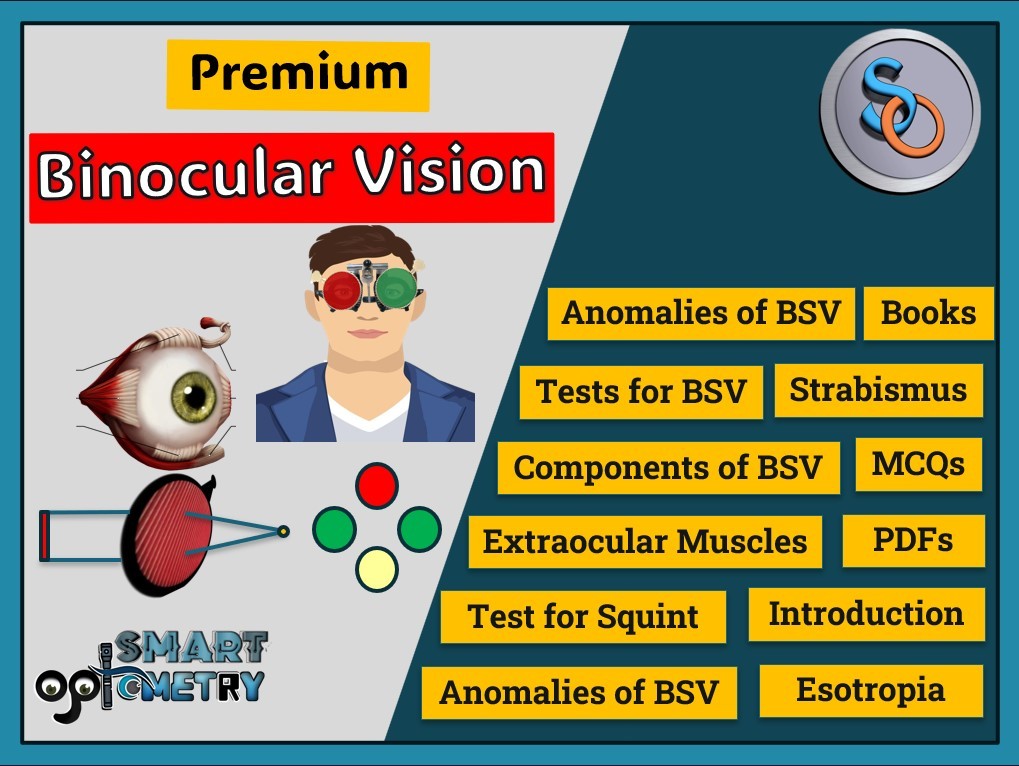
This course will cover: PDF-1: Why do we have two Eyes? • Why are eyes an important sense organ for us ? • Why do we need two eyes? • What are the benefits of having two eyes? • Demonstration of Two Eyes see slightly Different. • Why do we not have More than Two Eyes? PDF-2: Binocular Single Vision & Visual Field: • Types of Vision. • Visual Field and tis types. • Extend of visual field. • Temporal Crescent. • Visual Field of Different Species. • Side vs Front facing eyes. • Why do we not have 3 eyes? PDF-3: Visual Direction. • Visual Direction. • Primary Visual Direction. • Oculocentric Visual Direction. • Egocentric Visual Direction. PDF-4: Corresponding Retinal Points • Introduction of Corresponding Retinal Points. • Corresponding Retinal Points. • Non-corresponding Retinal Points. • Ray Diagram of Corresponding Retinal Points. PDF-5: Cyclopean Eye • Introduction of Cyclopean Eye. • Cyclopean eye vs Strabismus. • Cyclopean eye vs Crossed Diplopia. • Cyclopean eye vs Uncrossed Diplopia. PDF-6: Horopter Vs Punam’s Area • Introduction Horopter. • Introduction of Punam’s Area • The Vieth-Muller circle. • The Empirical h=Horopter. PDF-7: Development of Binocular Vision • Introduction of Development. • Physiological Factors. • Postural Reflexes. • Fixation Reflexes. PDF-8: Grades of Binocular Vision • Introduction of Grades of Binocular Vision. • Simultaneous Macular Perception. • Fusion. • Stereopsis. • Local Stereopsis. • Global Stereopsis. PDF-9: Extra-Ocular Muscles: Anatomy & Physiology. • Introduction of Orbital muscle. • Intraocular Vs Extraocular Muscle. • Levator Palpebral Superioris. • Medial Rectus: Origin, Insertion, Blood Supply & Nerve Supply. • Lateral Rectus: Origin, Insertion, Blood Supply & Nerve Supply. • Superior Rectus: Origin, Insertion, Blood Supply & Nerve Supply. • Inferior Rectus: Origin, Insertion, Blood Supply & Nerve Supply. • Actions of Extraocular Muscles. PDF-10: Ocular Motility: Monocular & Binocular • Table of Ocular Movements. • Monocular Ocular Movements. • Ductions Movements. • Binocular Ocular Movements. • Versions Movements. • Vergence Movements. • Saccadic Movements. • Pursuits Movements. PDF-11: Laws of Ocular Motility • Introduction of Laws of Ocular Motility. • Donders Law • Listing’s Law • Sherrington’s law • Hering’s Law. PDF-12:Ocular Motility Test • Introduction of Ocular Motility Test. • Procedure of Ocular Motility Test. • What to observe during the test. • Interpretation of Ocular Motility Test. Part-4: Tests for Assessing Binocular Single Vision. 1. Tests for Simultaneous Macular Perception. PDF-13: Bagolini's Striated Glass & Red Filter Test. • Introduction of tests. • Bagolini’s Striated Glass Test. • Red Filter Test. • PDF-14: Worth 4 Dot Tests • Introduction of Worth Four Dot Test. • Methods of Worth Four Dot Test. • Requirements for W4DT. • Procedure of Worth Four Dot Test. • Interpretation Worth Four Dot Test. • Indication of Worth Four Dot Test. 2. Tests for Fusion. PDF-15: Bagolini's Striated Glass. • Introduction of tests. • Bagolini’s Striated Glass Test. • Interpretation of Bagolini’s Striated Glass Test PDF-16: Worth 4 Dot Tests 3. Tests for Stereopsis: PDF-17: Tests for Stereopsis. • Introduction tests for Stereopsis. • Titmus Fly Test. • Titmus Animal Tests. • Titmus Circle Test. • Random Dot Stereo Test. • TNO random dot Test. • Lang Test. • Frisby Test. • Two Pencil Test. 5. Anomalies Affecting Binocular Vision. 6. Strabismus: 6.1. Introduction & Classification. 6.2. Strabismus Assessment. 7. Tests for Strabismus Assessment: 7.1. Krimsky & Modified Krimsky Test. 7.2. Maddox Rod Test. 7.3. Ocular Motility Test. 7.4. Bruckner Test. 7.5. Hirschberg Test. 7.6. Cover Test. 8. Esotropia: 8.1. Stages & Classifications. 8.2. Infantile or Congenital Esotropia. 8.3. Accommodative Esotropia. 9. Accommodation and Its anomalies: 9.1. Assessment Accommodation 9.2. Accommodation Insufficiency 9.3. Accommodation Inertia 9.4. Ill Sustain Accommodation 9.5. Paralysis of Accommodation 9.6. Excessive Accommodation 9.7. Spasm of Accommodation 10. Convergence and Its anomalies: 10.1. Convergence- An overview 10.2. Assessment of Convergence 10.3. Convergence Insufficiency 10.4. Convergence Paralysis 10.5. Convergence Spasm 🔔Note: ➡️You can use only one fixed model device (No Web/Laptop version available). If you purchase the course in one device and share it with anyone (friends) then you can't login to your mobile again. ➡️In valid cases such as: Phone lost/Phone broken/Bought new phone, you can change your device. ➡️To change your device you have to write a detail mail to our official Gmail mentioning your login details (Name, Mobile, Gmail). ➡️Our Official Gmail: optometrynotesmcqs@gamil.com